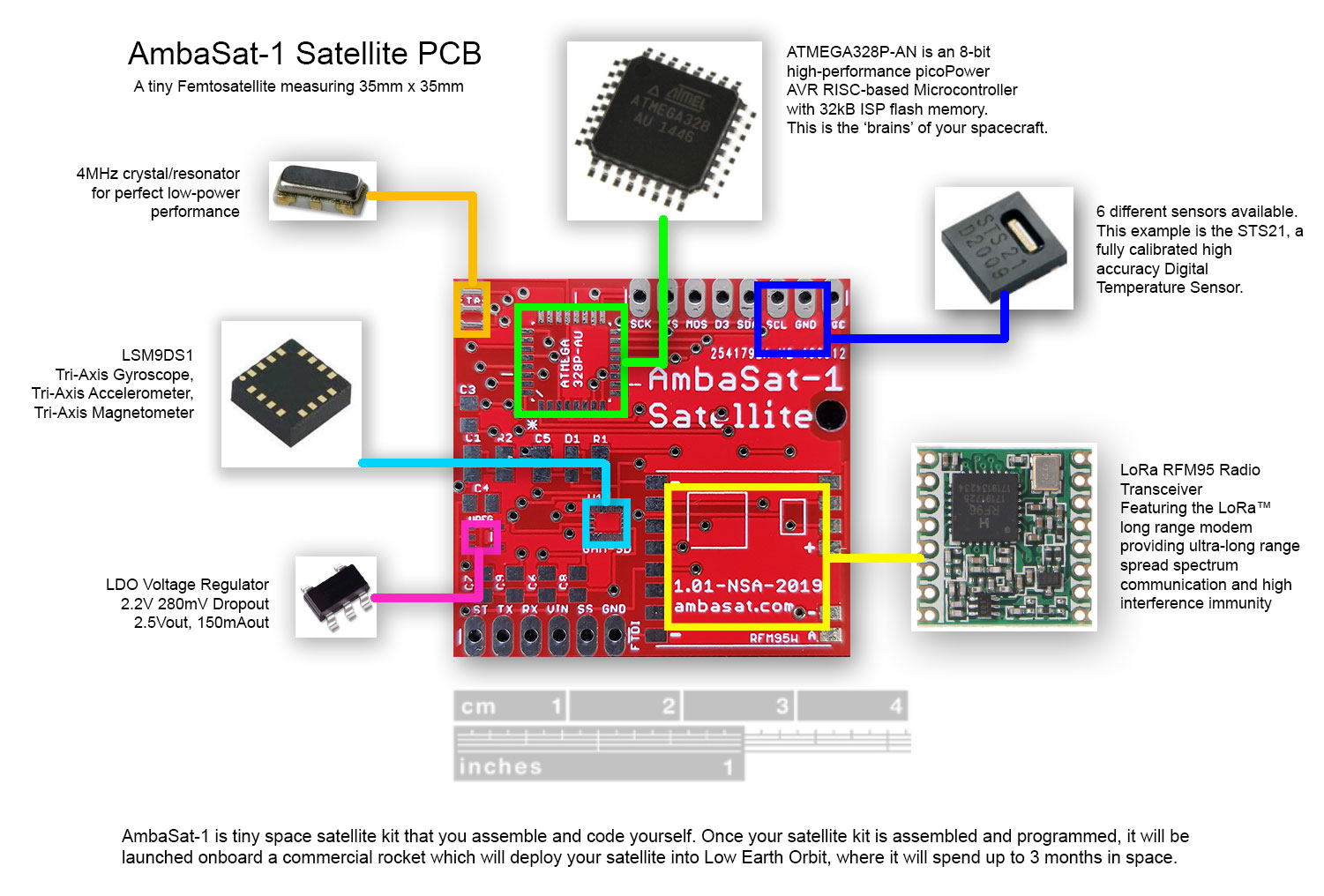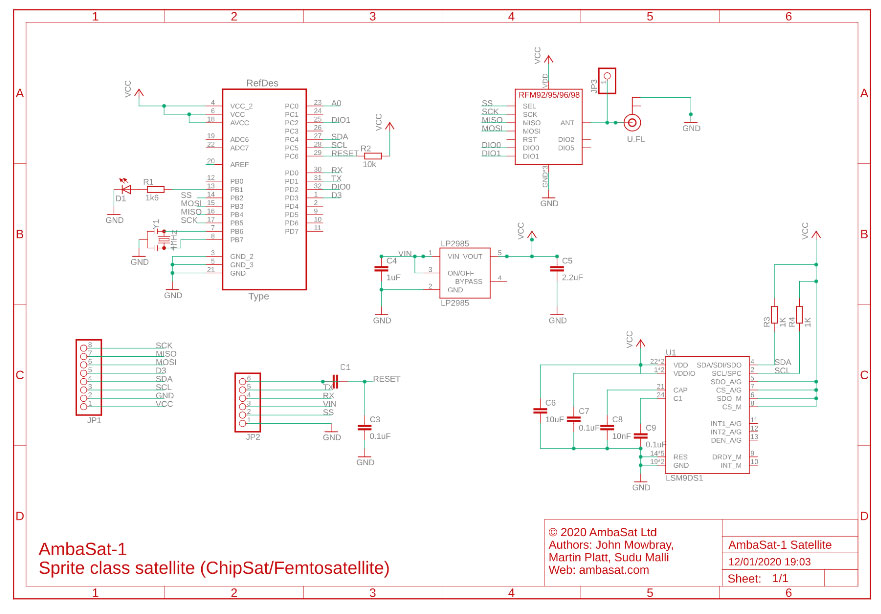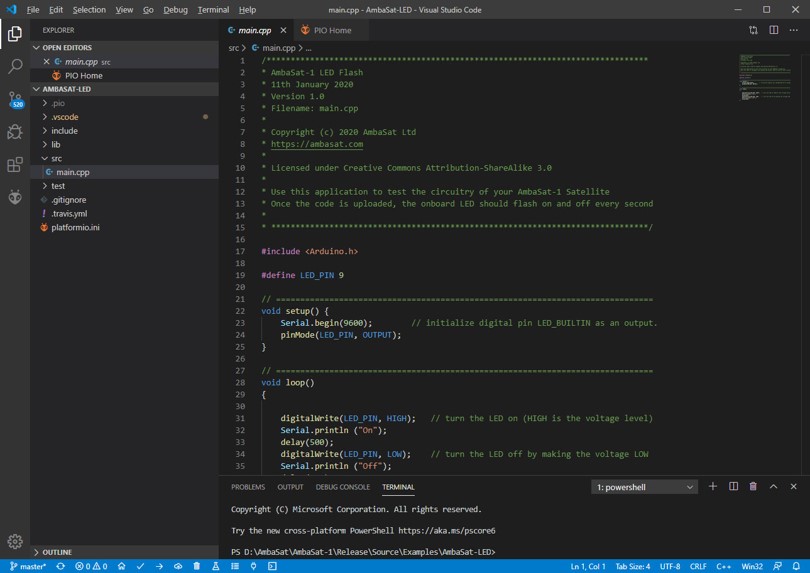BUILD AND CODE
Build and Code Your Own Space Satellite in ten hours or less
– Step-by-step guide & code examples
AmbaSat Build and Code
The AmbaSat Satellite kit is suitable for experienced electronics geeks, hardware and software professionals and also those with little or no previous coding or electronics experience.
Step-by-step guide and code examples
Anyone from 11-years-old and above can assemble their own AmbaSat Space Satellite. Follow the step-by-step guide on how to assemble your spacecraft, modify the existing code samples and program your satellite. The build time may vary depending on your skills and whether you have ever soldered before.
Electronics and Schematics

AmbaSat-1 uses off-the-shelf components and its ‘brain’ is one of the most popular MCUs (microcontroller unit) available today – the ATMEGA 328
https://en.wikipedia.org/wiki/ATmega328
The most up-to-date schematics are available from the AmbaSat GitHub page which is located at:
https://github.com/ambasat/AmbaSat-1/tree/master/Eagle
We use EAGLE to design the AmbaSat-1 boards and components.
EAGLE is an electronic design automation application with schematic capture, printed circuit board layout, auto-router and computer-aided manufacturing features. EAGLE stands for Easily Applicable Graphical Layout Editor
From Wikipedia: https://en.wikipedia.org/wiki/EAGLE_(program)
Eagle is available as a FREE download from the following link: https://www.autodesk.com/products/eagle/free-download
AmbaSat-1 Mainboard (Motherboard) Schematic

AmbaSat Satellite Coding

AmbaSat-1 uses Microsoft’s Integrated Development Environment (IDE) called Visual Studio Code. The Arduino IDE can also be used. We recommend using Visual Studio Code as it features plugins and extensions that we use to develop the AmbaSat code.
Visual Studio can be download for FREE from Microsoft at the following link:
https://code.visualstudio.com/download
AmbaSat-1 Source on GitHub
AmbaSat-1 source code and examples are located on GitHub. GitHub provides hosting for software development version control using Git. View and Download AmbaSat-1 source code from the following URL:

Sensor Options
Every AmbaSat-1 comes supplied with gyroscope, accelerometer and magnetometer sensors. These sensors come in the form of a single integrated chip (IC) which is called the LSM9DS1.
In addition to the LSM9DS1, when you select your AmbaSat kit, you get the option to choose which type of additional sensor you would like to fit onto your satellite.

AmbaSat sensors come on ‘daughterboards’. These are separate printed circuit boards which you solder onto the main AmbaSat board. Each sensor board measures about 15mm x 15mm. The main AmbaSat board communicates with the sensor using an interface known as I2C (I-squared-C).

The AmbaSat Sensor Range
Sensor 01: SHT30-DIS-F2.5KS
Humidity and Temperature – Best in class Humidity & Temperature Sensor. Fully calibrated, linearized, and temperature-compensated digital output with a wide supply voltage range, I2C Interface with communication speeds up to 1MHz and two user-selectable addresses.
Typical accuracy of 1.5 %RH and 0.1 °C. Very fast start-up and measurement time. All in a tiny 8-Pin DFN package.
Sensor 02: STS21
Temperature – A 3x3mm, fully calibrated digital temperature sensor with impressive performance. The temperature sensor features a I²C address and comes with outstanding accuracy and low power consumption.
Sensor 03: BME680
Gas, Pressure, Temp & Humidity – a low power gas, pressure, temperature & humidity sensor. It is a 4-in-1 multi-functional MEMS environmental sensor which integrates VOC (Volatile Organic Compounds) sensor, temperature sensor, humidity sensor and barometer.
Monitor 4 environmental parameters simultaneously. Widely used in environmental monitoring, home automation and control, Internet of Things (IoT) wearable device, GPS, etc.
Sensor 04: OPT3001DNPT
Ambient Light Sensor – The OPT3001 is a sensor that measures the intensity of visible light. The spectral response of the sensor closely matches the photopic response of the human eye, with infrared rejection. It is a single-chip lux meter, measuring the intensity of light as visible by the human eye.
The precision spectral response and strong IR rejection of the device enables the OPT3001 to accurately meter the intensity of light as seen by the human eye regardless of light source.
Sensor 05: ZMOD4410AI1V
TVOC (Total Volatile Organic Compounds) – Designed for detecting total volatile organic compounds (TVOC). The ZMOD4410 is a 12-pin LGA assembly (3.0 x 3.0 x 0.7 mm) that consists of a gas sense element and a CMOS signal conditioning IC.
The module’s sense element consists of heater element on a Si-based MEMS structure and a metal oxide (MOx) chemiresistor. The signal conditioner controls the sensor temperature and measures the MOx conductivity, which is a function of the gas concentration.
Sensor 06: SI1132-A10-GMR
UV Sensor – The Si1132 is a low-power, ultraviolet (UV) index, and ambient light sensor with I2C digital interface and programmable-event interrupt output. This sensor IC includes an analog-to-digital converter, integrated high-sensitivity visible and infrared photodiodes, and a digital signal processor.
The Si1132 offers excellent performance under a wide dynamic range and a variety of light sources including direct sunlight.
Sensor 07: CCS811B-JOPD500
TVOC & CO2 – The CCS811 is an ultra-low power digital gas sensor solution which integrates a metal oxide (MOX) gas sensor to detect a wide range of Volatile Organic Compounds (VOCs) and includes an Analog-to-Digital converter (ADC), and an I²C interface.
Supporting intelligent algorithms to process raw sensor measurements and output equivalent total VOC (eTVOC) and equivalent CO2 (eCO2) values.
Sensor 08: TESEO-LIV3R*
GPS – The Teseo-LIV3R module is an easy to use Global Navigation Satellite System (GNSS) standalone positioning receiver IC working simultaneously on multiple constellations. This certified module comes with optimized RF, embedded firmware and is compact at only 9.7×10.1 mm.
Supporting GPS, Glonass, BeiDou & QZSS positioning systems.
*Please note: Due to COCOM restrictions, the TESEO GPS receiver will only work on Earth
